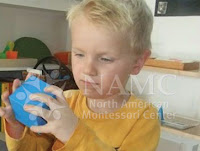 The Three Period Lesson is a fundamental technique used by Montessori educators to present new material to students. It is used throughout the Montessori curriculum and is extremely effective with teaching vocabulary. It uses three simple stages of teaching (naming , recognition and recall) and each stage gradually increases in difficulty. The first period is intended to introduce the concept, the second period allows for practice, and finally, the third period provides a demonstration of mastery.
The Three Period Lesson is a fundamental technique used by Montessori educators to present new material to students. It is used throughout the Montessori curriculum and is extremely effective with teaching vocabulary. It uses three simple stages of teaching (naming , recognition and recall) and each stage gradually increases in difficulty. The first period is intended to introduce the concept, the second period allows for practice, and finally, the third period provides a demonstration of mastery.Prior to carrying out a Three Period Lesson, it is important to be familiar with the vocabulary that you will be introducing and to have the necessary Montessori materials on hand. It is equally important to be sure the student is interested and ready to learn the concept that you are introducing. I always begin by inviting the child to join me for a lesson, so that they feel it is their choice. I might say, “Would you like to work with me?” or “Would you like to join me and learn some new words?”
For the purpose of this article, I will explain how I would use a Three Period Lesson to introduce three of the Geometric Solids (Cube, Sphere, Cylinder).
Montessori Technique Explained: How to Present a Three Period Lesson
The First Period (Naming): "This is..."This is the period when the desired vocabulary words are isolated (e.g., “cube”, “sphere”, “cylinder”) The teacher names each of the objects/cards and does so in a slow, simple manner. If I am introducing nomenclature cards, I simply point to each card. However, if I am introducing concrete objects, I like to actually pick up the object, feel it in my hands and place it back down on the floor mat.
Presentation
- Place all three Geometric Solids on the floor mat.
- Pick up the cube and state, “This is a cube”. Place it on the mat and again say the name, “cube”.
- Pick up the sphere and state, “This is a sphere”. Place it on the mat and again say the name, “sphere”.
- Pick up the cylinder and state, “This is a cylinder”. Place it on the mat and again say the name, “cylinder”.
The purpose of the second period is for the Montessori student to show you the specified object and card. If the objects are concrete and tangible, you should encourage the child to hold them, move them, and touch them in order to fully absorb the object with tactile movement and his senses. The second period is by far the most critical and enables the teacher to really observe whether the child is understanding the concept being presented. The children always enjoy the second period because it does involve an element of movement.
Presentation
- Randomly place the three Geometric Solids on the mat.
- Ask the student to show you the cylinder (or the last object named in the first period) by pointing to it with their finger.
- Repeat with the remaining solids. You can also ask them to manipulate the objects: place it on your hand, put it in a basket, hand it to another child, etc.
- If the child is unable to correctly identify the item, you should return to the first period. We should never correct a child, but instead make a mental note and go back to the first period. Again, point at each item and state the name. Remember, the second period is not an assessment period, it is still a learning period.
The third period is when the Montessori teacher asks the student to name or verbalize the concept or object. Some students will need to repeat the steps more than others and that is just fine. It is important to remember that the need for repetition is far more important than the need for mastery. Our goal is always to set the child up for success, so if the student makes an error in recalling the name, do not correct, but instead bring the lesson to a close and at another time, repeat the first two periods.
Presentation
- Place the three Geometric Solids on the mat.
- Point to one of the solids and ask the student “What is this?”
- Continue until the child has correctly identified each of the objects.
- When all three periods have been successfully completed, state what has been accomplished, “Now you know the names of three of the Geometric Solids: sphere, cube and cylinder and you may work with these whenever you like.”
- If the child is unable to correctly identify all three solids, quietly close the lesson and thank the child for working with you. Make a note for yourself indicating that the second period lesson should be repeated at another time.
As much as possible, NAMC’s web blog reflects the Montessori curriculum as provided in its teacher training programs. We realize and respect that Montessori schools are unique and may vary their schedules and offerings in accordance with the needs of their individual communities. We hope that our readers will find our articles useful and inspiring as a contribution to the global Montessori community.
© North American Montessori Center - originally posted in its entirety at Montessori Teacher Training on Thursday, November 11, 2010.
© North American Montessori Center - originally posted in its entirety at Montessori Teacher Training on Thursday, November 11, 2010.

Thanks for such informative post. Reflections are very crucial in children cycle of learning and development. (:
ReplyDeleteThank-you for your feedback, Izzy..... I couldn't agree with you more.
ReplyDelete